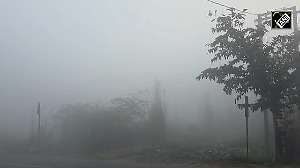The Reserve Bank of India may decide to wait for a while and not disturb the macro economic scenario by effecting a reverse repo rate hike in its forthcoming quarterly review of monetary policy on July 26. The reverse repo rate was last hiked by a quarter percentage point to 5 per cent in April.
A note of caution may, however, be sounded to alert the market of a tighter situation going forward in the fiscal.
While oil prices and below normal monsoon remain a concern, all other macro economic indicators call for a stable stance of the regulator to support growth at the present interest rate.
"It would be better to give the economy some time before hiking the rates immediately after the April credit policy," said a banker. Senior bankers said the RBI might issue a warning and leave the rate untouched for the time being.
"If it wants it may not wait for the October credit policy and announce a rate hike before that if the situation warrants so," pointed out a bank chairman.
Liquidity seems to be a problem at this point but the banking community said it was a temporary blip. Even though the reverse repo bids -- a measure of surplus liquidity in the system whereby banks park their excess funds with the RBI has shrunk -- it was primarily owing to a block in government expenditure.
The reverse repo bids have in fact gone up in the first two days of the week to almost Rs 20,000 crore (Rs 200 billion) from a low of Rs 3,000-4,000 crore (Rs 30-40 billion) last week.
At the same time, volumes in alternate money market instruments such as collateralised lending and borrowing obligation of Clearing Corporation of India have grown substantially.
Reserve money with RBI stood at 17.5 per cent against 12.8 per cent last year around the same time. On the other hand, money supply -- which indicates the liquidity in circulation -- has gone down from 15.2 per cent to 13.7 per cent.
This clearly indicates that the liquidity is calibrated to check its impact on the inflation rate. While supply side of liquidity seems comfortable, demand for funds arise from India Millennium Bond maturing in December, rising non-food credit offtake and the unfinished government borrowing programme.
However, at this point of time, the demand and supply is just being met comfortably.
Oil prices remain a constant pressure on the inflation but the RBI has already factored in a cost of $ 65 per barrel in its yearly projections.






 © 2025
© 2025